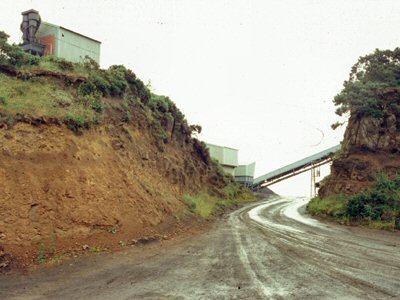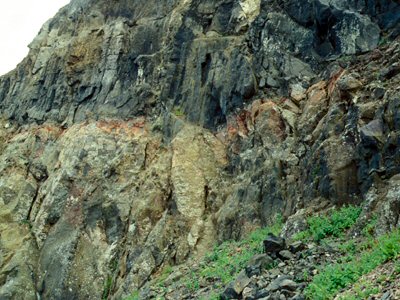| Site Type: | Quarry (working) |
| Site Status: | ESCR |
| Council area: | Ballymena District Council |
| Grid Reference: | D101071 |
| Google maps: | 54.89987,-6.28375 |
| Rocks |
|---|
| Rock Age: | Tertiary (Eocene) |
| Rock Name: | Interbasaltic Formation, Upper Basalt Formation |
| Rock Type: | Amydaloidal Basalt, Basalt, Bauxite, Ironstone, Laterite, Lignite |
| Interest |
|---|
| Minerals: | Analcime, Calcite, Chabazite, Gyrolite, Natrolite, Saponite, Thomsonite, Zeolites, Mesolite, Apophyllite |
| Other interest: | amygdales, pipe amygdaloid, subtropical |
Clinty Quarry is one of Northern Ireland's largest and works the Upper Basalt Formation, cutting through to the Interbasaltic Formation beneath. The basalts are rich in zeolite minerals but, as in all operational quarries, the faces change as extraction proceeds and with them the zeolites exposed. Zeolites are hydrated aluminium silicates of sodium, potassium, calcium and barium that are formed in the late stages of cooling of basaltic igneous rocks, usually coating the walls of enclosed bubbles (amygdales), fractures and cavities. The zeolites that are found normally reflect the depth of burial of the rocks during the process of their formation and Northern Ireland localities are particularly famous because the original research work to establish these zones was conducted here by G P L Walker in the 1950s. Clinty is situated in the chabazite-thomsonite zone, indicating only shallow burial. Antrim basalt zeolites are highly prized by collectors and there is a fine collection in the Natural History Museum in London assembled by Robert Bell, an ex-shipyard riveter, in the early part of the twentieth century. The Ulster Museum also has an extensive collection.
The Interbasaltic Formation yields bauxite (aluminium hydroxide), laterite (iron and aluminium hydroxide) and lignite (low rank brown coal). The bauxite and laterite were produced by the deep sub-tropical weathering of lava surfaces in humid conditions, normally in a climate with a pronounced dry season.



